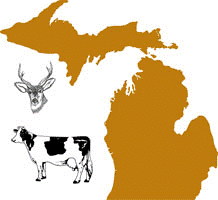Wildlife Disease and Zoonotics
Date of this Version
2002
Abstract
Setting:White-tailed deer represent the first wildlife reservoir of Mycobacterium bovis in the United States. The behavior of does with nursing fawns provides several potential mechanisms for disease transmission. Little information exists concerning transmission between doe and fawn, specifically transmammary transmission.
Objective: Determine if fawns can become infected by ingestion of milk replacer containing M. bovis, thus simulating transmission from doe to fawn through contaminated milk.
Design: Seventeen, 21-day-old white-tailed deer fawns were inoculated orally with 2x108 CFU (high dose, n=5), 2.5 x 105 to 2.5 x 106 CFU (medium dose, n=5), and 1x104 CFU (low dose, n=5) of M. bovis in milk replacer. Dosages were divided equally and fed daily over a 5-day period. Positive control fawns (n=2) received 1x105 CFU of M. bovis instilled in the tonsillar crypts. Fawns were euthanized and examined 35-115 days after inoculation and various tissues collected for bacteriologic and microscopic analysis.
Results: All fawns in the tonsillar, high oral and medium oral dose groups developed generalized tuberculosis involving numerous organs and tissues by 35-84 days after inoculation. Three of five fawns in the low-dose oral group had tuberculous lesions in the mandibular lymph node, and one of five had lesions in the medial retropharyngeal lymph node when examined 115 days after inoculation.
Conclusion: White-tailed deer fawns can become infected through oral exposure to M. bovis. Therefore, the potential exists for fawns to acquire M. bovis while nursing tuberculous does.



Comments
Published in Tuberculosis (2002) 82(4/5),161-165.